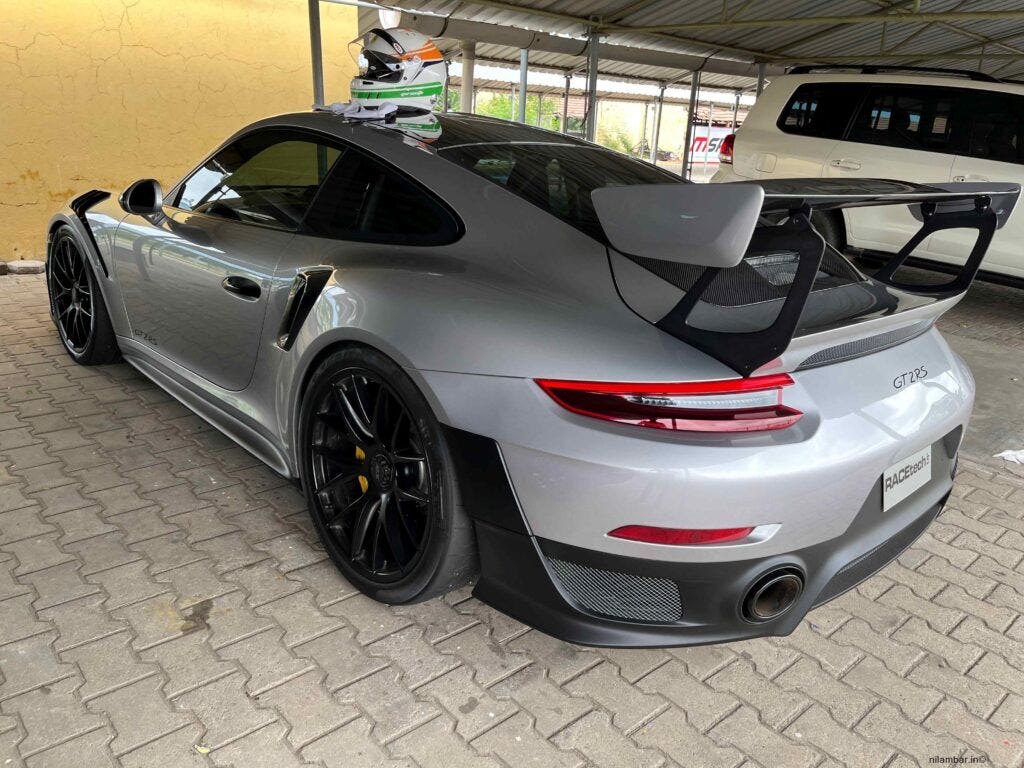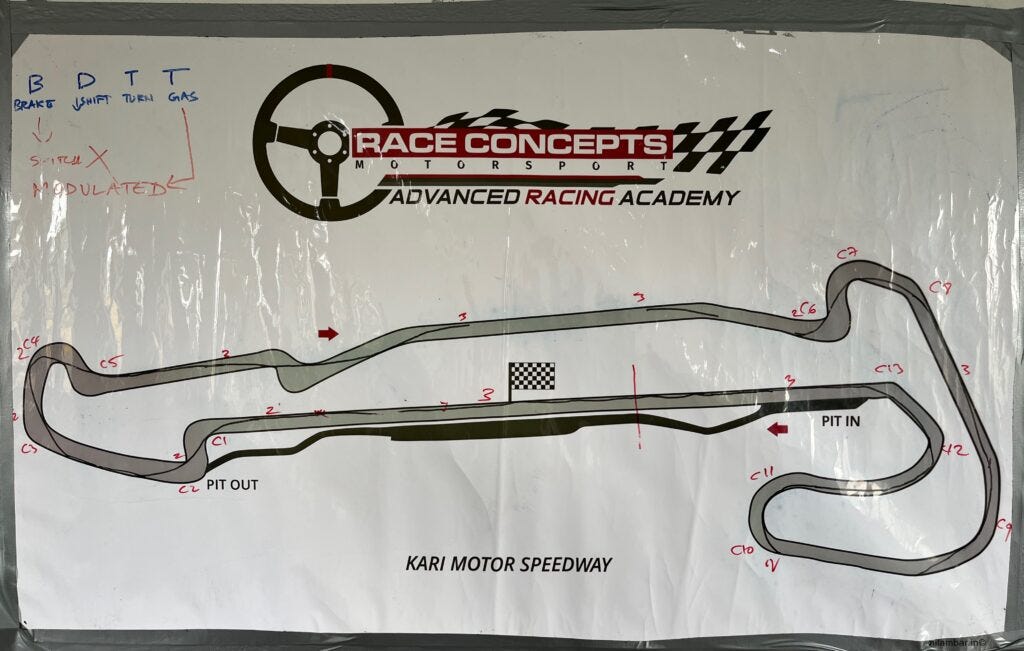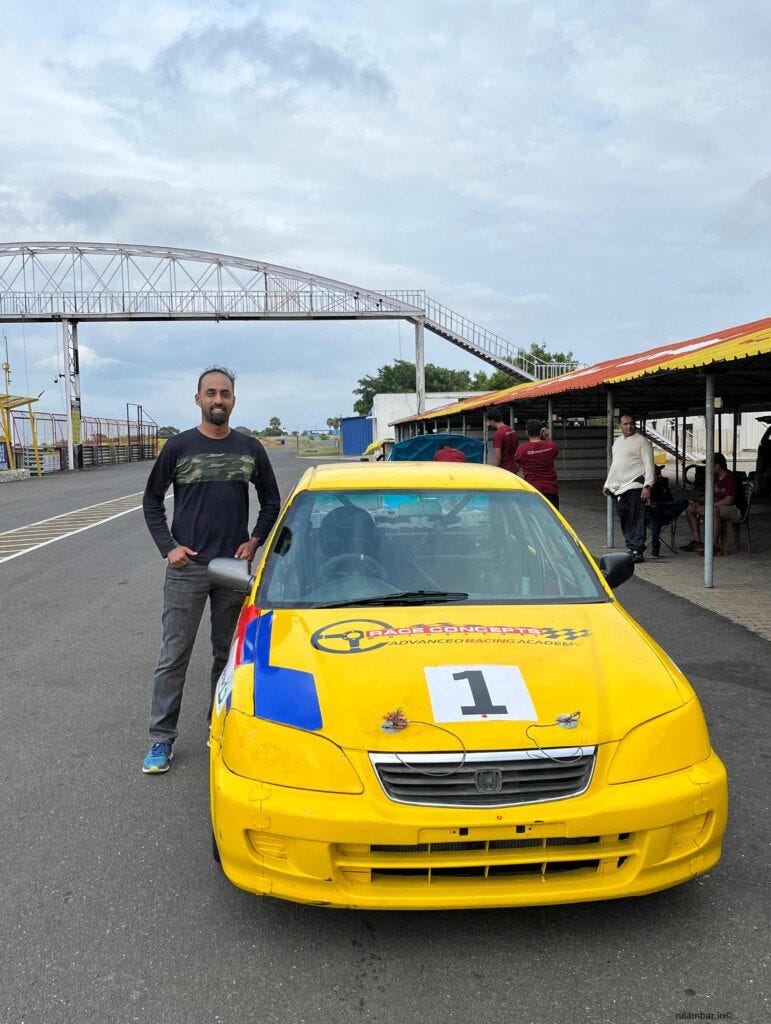Training to race
If you had asked "pre-teen me" what I would like to be when I grew up, I would have said: an F1 driver who plays in the ATP tour in the off-season!
Needless to say, I remained a spectator of these sports. After I crossed 30, I did manage to learn and play some tennis but my body broke down along the way.
It took years to recover and build my fitness! I have not yet resumed tennis although I am hopeful.
Meanwhile my racing itch remained to be scratched. But India is a bad place to experience performance cars on a tight budget.
My only taste of racing was on occasional trips to a karting track. It is great fun but ends quickly with a toy-like experience.
One of the enthusiasts in my car owners' Whatsapp group told us about Race Concepts. Race Concepts is an Indian racing company who participate in several categories of motor racing in India.
They start with cars like the Honda City VTec and modify them to extract the best performance on a track.
They run a 2-level, advanced driving course each spanning 2 days. You get to drive their actual racing spec cars on a proper race-track. Expert guidance from experienced racers is included!
A tentative start
The Kari Motor Speedway is relatively small racetrack in the outskirts of Coimbatore. The taxi driver asked me if there was a race going on. But this was the off-season.
I got off with a bloated backpack that held my rented helmet and gloves. May in Tamil Nadu is supposed to feel like a tandoor, but the sun was gentle and the breeze firm.
People were trickling in. About a dozen trainees from many parts of India. There were two ladies among us, both in Level 2. I was in Level 1 with the beginners.
The mechanics were busy setting up the cars. We realized that most of the metal panels had been replaced with fibre. The engine bay was airy because most of the unnecessary systems are thrown out.
The trainers included Arjun Balu who has won several championships across tracks and rallies.
There were other racers and a supercar owner who were sharing the track. Track-time is very expensive even at this smallish track.
Another notable arrival was a huge freezer! The staff filled in a gazillion bottles of water and fluids. Snacks were also laid out.
The instructors were on their walkie talkies figuring out the logistics. They had to coordinate with the track staff who would monitor the cars while they were on track.
I spoke to a few of my fellow trainees while we waited.
One guy (married and in his late 20s) said he hadn't told his Mom about coming here because she wouldn't let him go. Another guy said his uncle called and asked him if he planned to become the next Schumacher.
Indian parents: 2, Wannabe racers: 0!
The youngest was a 19 year old who had driven more on a track than on normal roads. The oldest was a techie in his late 40s.
Meanwhile there was a rare track animal, the Porsche GT-2 RS, with its own transport truck for us to drool over!
Soon it was time to decide who gets which car. We were asked to strap in and check which car was most ergonomically suited to each of us.
The insides were barebone. All unneccessary equipment was removed. A rollcage was there to keep us safe along with 5-point safety belts.
It was late morning when we beginners were herded into a conference room for a quick briefing.
They started from basic concepts. Eye movements were important. We were to look at the furthest we could see down the track. That would orient us to the racing line and set the cue for our actions.
Racing on a track is simply a matter of driving as quickly as you can around the track while not losing traction. Traction is the term for having contact with the tarmac with control.
Traction requires the wheels to be rolling. If the wheels lock up, you are sliding and not rolling. Without traction you cannot steer: no control.
Every time we turn the steering our momemtum generates an outward force that tries to throw the car and driver away from the corner.
In a road car, we drive in mandated lanes at much lower speeds and typically don't feel any significant forces. These "g-forces" are the biggest differences between the "feel" on a track versus a road.
Riders of roller-coasters will know this feeling!
When turning, we need to use braking force to reduce speed and carry just the right amount of momentum through a corner to maintain traction.
So the idea is to keep the car as close to a straight line with full throttle for as long as possible. We bunch up all the braking and steering work within the shortest possible interval. The path that achieves this is called the racing line.
This picture shows how we turn into a typical corner coming in from the outer edge of the track into the inner corner (the apex) and then apply throttle and reach the outer edge on the exit.

You can checkout this video to know more: Paradigm Shift Driver Development: Racing Line
We had to follow the BDTT (Brake, Downshift, Turn, Throttle) formula and go to a maximum of 3rd gear. This would keep the shifting to a minimum. We had to do just 3 up-shifts and 3 down-shifts in the whole lap.
With the theory done, we headed to the pits.
Learning by doing
My first taste of the track was sitting shotgun with an instructor. There was an outlap from the pits, then a flying lap and then another to get back into the pits.
I anchored myself the best I could. One leg far out to the body of the car, one hand holding the crash cage and my heart in my mouth!
We were supposed to observe the racing line and understand his actions and their timing.
It happened all too quickly and I was out into the pits again.
The next round was a convoy type exercise to learn the racing line. After the outlap, each car would follow right behind the lead car for 2 laps then let the car behind them come up ahead and retreat to the back of the line.
This gave us a few laps of learning to keep up, adjust to the pace and understand the lines.
It was exhausting!
Then we had to drive on our own, 2-3 laps each time. There were a lot of spins from the more aggressive drivers. I was a bit too conservative and not going fast enough.
The best drivers were the youngest who had driven the least on the roads. They had no unlearning to do.
The rest of us were braking with not enough force for far too long or riding the clutch. We were changing gears when turning, increasing the chances of a bad lap or risking a spin.
We had just one theory lesson (BDTT) and we forgot about it! I found myself zoning out some times: missing gear changes and looking at the scenery.
When you drive on the road, you can hum a tune, listen to a podcast or have conversations. This is because our brain is wired to drive in mild traffic.
But the track demands focus. The brain hates to be taxed like this and burns through a lot of energy and fluids.
Now I understood why we had a freezer full of fluids and so many snacks. I needed about a litre of water for every 10 minutes of driving!
We took stock at the end of Day 1. The instructors decided to demonstrate braking technique.
On a road sometimes you have to slam the brakes when an animal crosses. Most of us don't do this right. But we get away because ABS technology saves the day.
The cars we drove didn't have ABS. If you brake too hard, the wheels lock and the car slides. To prevent this you have to calibrate your braking.
You don't slam the pedal but you firmly and progressively press the brake pedal as you feel the car slowing down. If you feel the car sliding, you have to stop braking and regain steering control and then brake again.
So the approach was to brake (B) at every corner as if someone had suddenly appeared in front of you. The demo helped us understand the braking distance.
While the car is slowing down, you also downshift (D).
Then you turn (T) into the apex with both hands on the steering and go to full throttle (T) at the apex.
Good braking gives you confidence. That translates into better times. So going into Day 2, all of us were more confident. We reached higher speeds on the straight and dared to go to the 4th gear.
This meant 2 downshifts before turn 1. It was fun trying to get the steps right. The focus was a bit easier.
By afternoon on Day 2, I understood the car better and was able to do some very good focused laps.
A high and a low
In the morning of Day 2, I got to ride (not drive) in the GT2-RS. It was a brute of a machine, way more powerful than the cars we were using. The brake discs looked larger than Rajasthani thali plates!
The acceleration would push you back into your seat with a thud and your ability to brake much later meant higher speeds.
These cars could drive on a more bendy racing line because they are much quicker to lose or gain speed. You can tailor the speed appropriately to track position.
Compared to this, V-Tecs had to take larger curves around the corners as you had to try and carry more speed (momentum) into the corner to compensate for slower acceleration afterward.
I got the hang of this and kept improving my driving late into the afternoon. My confidence was peaking when I came out on to the main straight on my penultimate run.
I reached my best speed and braked exactly like before ahead of turn 1. But the car did a bit of a wobble. I think the rear tyres just slightly locked up. I managed to get through the turn and the rest of the lap.
Again coming up the main straight to turn 1, I did my usual braking and the wheels locked up again. This time I lost steering control. I let go of the brakes. I was supposed to regain steering control and brake again. But by then I was off track.
All the safety gear worked and I managed to not drive into anything. I stopped in the gravel about 40m away. They got me and the car back to the pits.
I could feel my confidence draining out as they inspected the car for damage. No mistakes at all until now and then this!
The cars characteristics change as the brakes and tyres wear out with more laps. Braking gets trickier and one had to adjust for that.
The instructors didn't lecture me. Driving a race car teaches you lessons on its own.
To their credit, they let me do my last set of laps. I was much slower than before, and still not braking or following the racing line very well.
I was expecting a problem at every corner, finding relief as I passed each one without leaving the tarmac. Somehow, I managed to finish without further incident.
I was left wondering how many more laps I would need to clear my head, as the sun disappeared behind the horizon. We wrapped up the weekend with a debriefing and some pictures, then dispersed, back to driving on roads and traffic.









